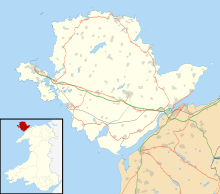Beddmanarch–Cymyran
| Site of Special Scientific Interest | |

Low tide at Traeth y Gribin
|
|
| Area of Search | West Gwynedd |
|---|---|
| Grid reference | SH 275 790 |
| Coordinates | 53°17′00″N 4°35′16″W / 53.28345°N 4.5879°WCoordinates: 53°17′00″N 4°35′16″W / 53.28345°N 4.5879°W |
| Interest | Biological |
| Area | 911 hectares (2,250 acres) |
| Notification | 1961 |
Beddmanarch–Cymyran is a site of special scientific interest (SSSI) on Anglesey extending to just over 900 hectares (2,200 acres), and is centred on the Cymyran Strait. It was first notified in 1961 for its coastal botanical and ornithological interest. The site is also a marine protected area as it includes intertidal areas and contains marine components.
The Beddmanarch–Cymyran site comprises the area of coastal salt-marshes, mud-flats and shallow coastal water lying between Holy Island and the mainland of Anglesey. This includes the Cymyran Strait (sometimes called the Holy Island Strait), the tidal reaches of the Afon Alaw to the east and extends northwards to Porth Penrhyn-Mawr. There are two crossings over the water that makes up the site, Four Mile Bridge (road and pedestrian) and the Stanley Embankment (road, rail and pedestrian). The area between the two bridges in known as the Inland Sea.
The site includes four special areas of interest:
More generally, the area is also important for a mixture of environments including mudflats and sandbanks, tidally swept areas of bedrock, rock outcrops, shingle bars, muddy gravels, and coastal grassland and scrub. All of these support a variety of wildlife including breeding birds, such as arctic and common terns, and plants like dwarf rush (Juncus capitatus) and spiral tasselweed (Ruppia cirrhosa).
As a marine protected area the site is important for the common ringed plover (Charadrius hiaticula), common greenshank (Tringa nebularia), eel grass and tide-swept algae, and for its inter-tidal, salt marsh, muddy gravel, and sheltered mud environments.
The wintering populations of the ringed plover and greenshank are monitored by the RSPB.
While many activities can damage protected sites, Beddmanarch–Cymyran SSSI is sensitive to a number of possible changes and activities:
...
Wikipedia

